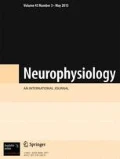The latency and amplitude of the auditory evoked Р300 potential were measured in 25 elderly and old persons without any cognitive impairments (control group), 32 patients with mild neurocognitive disorder induced by Alzheimer’s disease (AD MNCD), and 33 patients with analogous impairment of subcortical vascular genesis (SCV MNCD). The examined groups did not differ from each other significantly in age, sex, and educational level. It was found that the mean latency of the Р300 wave in patients suffering from SCV MNCD (507.9 ± 203.6 msec) was significantly longer as compared with the analogous parameter in two other groups. The value of such increment allows one to differentiate SCV MNCD from the groups without cognitive impairment (326.9 ± 103.6 msec, Р = 0.00005) and AD MNCD (378.9 ± 99.9 msec Р = 0.0007). The increased P300 latency is related to the severity and clinical specificity of SCV MNCD and reflects a crucial influence of the microvascular cerebral frontosubcortical injury on the generation of this neurophysiological phenomenon. We conclude that the level of increase in the latency of wave Р300 can be used as a valid neurophysiological marker for differential diagnostics of MNCDs of the main etiological types.
Similar content being viewed by others
References
Diagnostic and Statistical Manual of Mental Disorders, Am. Psychiat. Assoc., Arlington (2013).
R. C. Petersen, G. E. Smith, S. C. Waring, et al., “Aging, memory, and mild cognitive impairment,” Int. Psychogeriat., 9 , Suppl. 1, 65-69 (1997).
R. C. Petersen, B. Caracciolo, C. Brayne, et al., “Mild cognitive impairment: a concept in evolution,” J. Int. Med., 275, No. 3, 214-228 (2014).
E. M. Ebly, D. B. Hogan, and I. M. Parhad, “Cognitive impairment in the nondemented elderly: results from the Canadian study of health and aging,” Arch. Neurol., 52, No. 1, 37-42 (1995).
K. Ritchie, S. Artero, and J. Touchon, “Classification criteria for mild cognitive impairment: a populationbased validation study,” Neurology, 56, No. 1, 37-42 (2001).
H. Jacqmin-Gadda, A. Alperovitch, C. Montlahuc, et al., “20-Year prevalence projections for dementia and impact of preventive policy about risk factors,” Eur. J. Epidemiol., 28, No. 6, 493-502 (2013).
Y. Cheng and S. Xiao, “Recent research about mild cognitive impairment in China,” Shanghai Arch. Psychiat., 26, No. 1, 4-14 (2014).
H. Ishii, K. Meguro, S. Yamaguchi, et al., “Prevalence and cognitive performances of vascular cognitive impairment on dementia in Japan: the Osaki-Tajiri Project,” Eur. J. Neurol., 14, No. 6, 609-616 (2007).
R. V. Pedroso, F. J. Fraga, D. I. Corazza, et al., “P300 latency and amplitude in Alzheimer’s disease: a systematic review,” Braz. J. Otorhinolaryngol., 78, No. 4, 126-132 (2012).
O. A. Levada, A. V. Trailin, A. L. Kvitka, and O. V. Stolbinskaia, “P300 potential parameters at the stages of formation of the subcortical vascular dementia in elderly,” Lik. Sprava, Nos. 1/2, 60-66 (2014).
T. W. Picton, “The P300 wave of the human eventrelated potential,” J. Clin. Neurophysiol., 9, 456-479 (1992).
B. F. O’Donnell, S. F. Faux, R. W. McCarley, et al., “Increased rate of P300 latency prolongation with age in schizophrenia. Electrophysiological evidence for a neurodegenerative process,” Arch. Gen. Psychiat., 52, 544-549 (1995).
M. A. Parra, L. L. Ascencio, H. F. Urquina, et al., “P300 and neuropsychological assessment in mild cognitive impairment and Alzheimer dementia,” Front. Neurol., 3, 172 (2012).
T. Frodl, H. Hampel, G. Juckel, et al., “Value of eventrelated P300 subcomponents in the clinical diagnosis of mild cognitive impairment and Alzheimer’s disease,” Psychophysiology, 39, 175-181 (2001).
E. J. Golob, J. K. Johnson, and A. Starr, “Auditory eventrelated potentials during target detection are abnormal in mild cognitive impairment,” Clin. Neurophysiol., 113, 151-161 (2002).
E. J. Golob, R. Irimajiri, and A. Starr, “Auditory cortical activity in amnestic mild cognitive impairment: relationship to subtype and conversion to dementia,” Brain, 130, 740-752 (2007).
G. B. Frisoni, S. Galluzzi, L. Bresciani, et al., “Mild cognitive impairment with subcortical vascular features: clinical characteristics and outcome,” J. Neurol., 249, No. 10, 1423-1432 (2002).
M. F. Folstein, S. E. Folstein, and P. R. McHugh, “Minimental state: a practical method for grading the cognitive state of patients for the clinician,” J. Psychiat. Res., 12, 189-198 (1975).
M. R. Schoenberg and J. G. Scott, The Little Black Book of Neuropsychology, Springer Science+Business Media, LLC (2011).
D. J. Libon, R. A. Swenson, E. J. Barnoski, and L. P. Sands, “Clock drawing as an assessment tool for dementia,” Arch. Clin. Neuropsychol., 8, 405-415 (1993).
J. G. Borkowski, A. L. Benton, and O. Spreen, “Word fluency and brain damage,” Neuropsychology, 5, 135-140 (1967).
J. L. Cummings, M. Mega, K. Gray, et al., “The neuropsychiatric inventory: comprehensive assessment of psychopathology in dementia,” Neurology, 44, 2308-2314 (1994).
Z. Katsarou, S. Bostantjopoulou, V. Kimiskidis, et al., “Auditory event-related potentials in Parkinson’s disease in relation to cognitive ability,” Precept. Mot. Skills, 98, 1441-1448 (2004).
F. Vecchio and S. Määttä, “The use of auditory eventrelated potentials in Alzheimer’s disease diagnosis,” Int. J. Alzheimer’s Disease, 2011, Article ID 653173, 7 P, doi:10.4061/2011/653173 (2011).
Author information
Authors and Affiliations
Corresponding author
Additional information
An erratum to this article is available at http://dx.doi.org/10.1007/s11062-017-9635-9.
Rights and permissions
About this article
Cite this article
Levada, O.V., Cherednichenko, N.V. & Gorbachev, S.V. Parameters of the P300 Potential in Mild Neurocognitive Disorders of Different Etiologies. Neurophysiology 48, 414–420 (2016). https://doi.org/10.1007/s11062-017-9618-x
Received:
Published:
Issue Date:
DOI: https://doi.org/10.1007/s11062-017-9618-x



